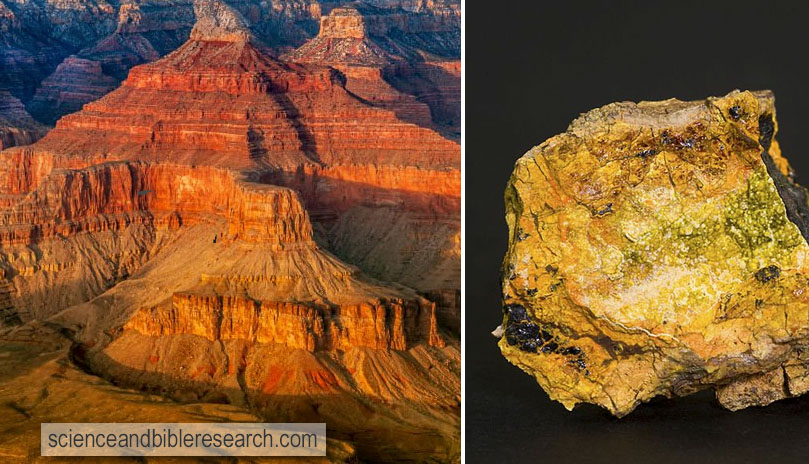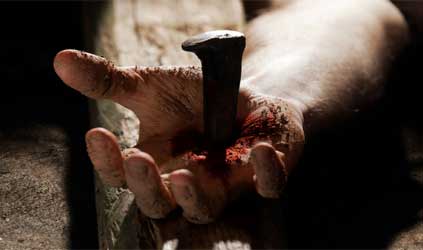November 18, 2023
Steve Sabz

Grand Canyon national park (Photo by joebelanger) and Wolsendorfite from Bavaria, Germany with uranium, lead and calcium minerals (Photo by MarcelC)
In the previous article, I showed how a young earth (i.e., 6,000 years old as per Young Earth Creationism) is not a necessary conclusion of the Genesis narrative, but rather, a misuse of the genealogies and a violation of the author's intent. In this article, we shall see how Young Earthers already conceded the accuracy of radiometric dating and its deep time results after an eight-year long research endeavor whose findings were published in the RATE II: Radioisotopes and the Age of The Earth: Results of a Young-Earth Creationist Research Initiative, (Volume II), L. Vardiman et al., eds. (San Diego, CA: Institute for Creation Research and the Creation Research Society, 2005).
The RATE (RADIOISOTOPES AND THE AGE OF THE EARTH) Project was financed by ICR (about $250,000) and over 400 donors who contributed more than $1 million (source, p. xxx).
Research conducted by Dr. Andrew A. Snelling, published and funded by the Institute for Creation Research (ICR) and the Creation Research Society (CRS) in RATE II, used the Uranium–Lead (U-Pb) radioisotope system of dating rocks. Dr. Snelling found "unequivocal confirmation" of deep time in the Cambrian Grand Canyon tuff beds:
The fact that the thermal annealing of the fission tracks and the thermal resetting of the U-Pb radioisotope system in those zircon grains were exactly parallel is unequivocal confirmation that the radioisotope ratios are a product of radioactive decay, in just the same way as the fission tracks are physical evidence of nuclear decay
Dr. Andrew A. Snelling in Fission Tracks in Zircons:
Evidence for Abundant Nuclear Decay, p. 210 (2005)
Dr. Snelling used fission tracks (a physical record of in situ nuclear decay) and the measured amount of nuclear decay in the same rock sample to confirm more than 500 million years worth of nuclear and radioisotope decay:
...there remains sufficient strong evidence to conclude that both the fission tracks and radioisotope ratios in the zircons in the Cambrian Grand Canyon tuff beds record more than 500 million years worth (at today's rates) of nuclear and radioisotope decay during deposition of the Phanerozoic strata sequence of the Grand Canyon-Colorado Plateau region.
Dr. Andrew A. Snelling in Fission Tracks in Zircons:
Evidence for Abundant Nuclear Decay, p. 210 (2005)
Dr. Snelling rejects the uniformitarian model of constant decay rates, but rather, adopts a controversial vision of accelerated radiometric decay which occurred during the year-long global Flood 4,500 years ago:
Given the independent evidence that most of this strata sequence was deposited catastrophically during the year-long global Flood about 4500 years ago, then 500 million or more years worth (at today's rates) of nuclear and radioisotope decay had to have occurred during the Flood year about 4500 years ago.
Dr. Andrew A. Snelling in Fission Tracks in Zircons:
Evidence for Abundant Nuclear Decay, p. 210 (2005)
In order for Dr. Snelling's above scenario to work, the decay rates would need to be accelerated by at least six orders of magnitude. In other words, 500 million years worth of nuclear decay would have to be squeezed into the timespan of a single year. Snelling admits this would generate an "enormous amount of heat." Snelling provides a calculation which demonstrates the admitted "heat problem":
To put this heat problem in perspective we can quickly do a rough estimate of the effect of just the accelerated nuclear decay, say 500 million years worth (at today's rates), but instead taking place in a single year (the Flood year). The following values of the relevant parameters were obtained from Stacey [1992]:
• the typical heat production in a granitic pluton from radioactive decay of U, Th, and K is ~10-9 W/kg,
• the specific heat of granite is ~700 J/kg-K, and
• the number of seconds in 500 million years is ~1.6 x 1016 sec.
Thus the adiabatic temperature rise =
(1.6×1016 sec)×(10-9 W/kg) 700 J/kg-K = 22,400K
This is equivalent to a temperature rise of more than 22,000°C, which
is sufficient, of course, to vaporize a granitic pluton many times over!
Dr. Andrew A. Snelling in Radiohalos in Granites: Evidence for Accelerated Nuclear Decay, p. 183 (2005)
The above conditions would sterilize the earth of all kinds of living organisms. Noah and the occupants on the ark would have died during their year-long voyage aboard the ark (Gen 7:11, Gen 8:13). For example, "complete DNA degradation occurs at above 190°C" (source). Single-celled organisms such as archaea and bacteria cannot grow at temperatures above 122°C and 100°C respectively, while most eukaryotes cannot complete their life cycles above 40°C (source). The chemical foundation for life on earth, carbon, vaporizes at temperatures above 4000 K or 3727°C (source).
Snelling admits that "All creationist models of young earth history have serious problems with heat disposal" (source, p. 184). Consequently, he cites young earth physicist, Dr. Russell Humphreys' proposed solution in, New Mechanism for Accelerated Removal of Excess Radiogenic Heat (2018), which involves a supposed "opening of the heavens" during Noah's Flood, allowing the excess heat to be radiated into hyperspace. However, Humphreys acknowledges that this would not prevent Noah and all of the occupants aboard the ark from dying due to the intense heat (p. 737).
Even more, Snelling's hypothesized accelerated radioactive decay does not align with Scripture. For example, the prophet Jeremiah declares several times that God's natural laws are fixed and do not change (Jer 31:35-36, Jer 33:25). Furthermore, such an astronomical event would require nothing less than a miracle. Unfortunately for the Young Earther, Scripture does not describe (implicitly or explicitly) any sort of divine intervention taking place before, during, or after Noah's Flood.
Even though Young Earthers admit deep time from radiometric dating (as clearly shown above), they persist in their attempts to disqualify the method and those who hold to an old earth view. For example, geologist Dr. Tim Clarey of ICR (the organization that published RATE II in 2005), argues that these dating methods are "inaccurate":
What geologists use for really old, what they say are old rocks, to get these old dates which we don't believe are accurate... potassium-argon... uranium-lead... we think there are so many assumptions built into all methods that most of those methods that get the millions and billions of years are inaccurate, and your can't verify them.
Dr. Tim Clarey in Can Radioisotope Dating Be Trusted? | The Creation Podcast: Episode 36 (time 6:05, 2022)
In the same interview, Dr. Clarey mentions the RATE Project (time 9:25), and talks about the Uranium-Lead dating method. This time, he says scientists are getting the, "today's decay rates accurate," and adds that the decay rates "seem to be [measured correctly] for the most part." He also talks about the decay rates changing but never to the extent necessary to squeeze 500 million years worth in the year of Noah's Flood when the "heat problem" ends up killing all life on planet Earth (time 11:40). Toward the end of the interview, Clarey mentions the Mount St. Helens rock sample (time 22:35), which we shall discuss below.
In a recent interview on Creation Ministries International (CMI) YouTube channel, geologist Tas Walker discussed the results of radiometric dating on a rock sample acquired from the Mount St. Helens (Washington State, USA) eruption in 1980. The 'whole rock' sample, which formed about 10 years after the eruption, was sent to Geochron Laboratories of Cambridge, Massachusetts and yielded an age of 350,000 years. The results of the study were published by Dr. Steve Austin in a paper titled, Excess Argon Within Mineral Concentrates from the New Dacite Lava Dome at Mount St Helens Volcano (1996). Because of these results, Dr. Walker questions the validity of the radioisotope Potassium-Argon (K-Ar) dating method, saying, "...the lessons of Mount St. Helens [rock sample] is direct evidence that the dating methods... there's a problem with them... a big problem" (source, time 35:05, 2023). At the same time, he acknowledges that this "problem" with radiometric dating doesn't prove the earth is young.
Dr. Austin's research on the ten-year old volcanic rock sample and its grossly overestimated radiometric age drew criticism from the scientific community. Primarily, that the instruments used by the laboratory at the time were not designed to analyze rock samples younger than two million years (source). In the CMI interview above, Dr. Walker was asked whether or not Dr. Austin told the lab the origin of the rock and it's date of formation. He answered, "I can't remember if he told them exactly that in this case. Often that is required so that the laboratory knows the ballpark of where, what sort of date to expect, and how to calibrate, and how to adjust their instruments." (source, time 3:55, 2023). Dr. Austin's paper reveals that he did not tell the lab where the rock sample came from or that it was only ten years old (source, under K-Ar analysis). In this way, Dr. Austin's dishonest communication with Geochron Laboratories in regard to his rock sample renders the results invalid because he did not follow the lab's standard submission protocol.
CITE:
Sabz, S. (2023, November 18). Young Earthers Admit Old Rocks. Retrieved from
https://scienceandbibleresearch.com/young-earthers-admit-old-rocks.html
Steve Sabz
Steve Sabz is the author and founder of Science and Bible
Research. He has been studying theology since 2015 and has successfully completed seminary level
courses in Textual Criticism, Biblical Hermeneutics, Eschatology, Puritan Theology, Ancient Church
History, Soteriology, Biblical Theology, Prolegomena, and Biblical Greek from Puritan Reformed
Theological Seminary, Southern Baptist Theological Seminary, and Dallas Theological Seminary.






